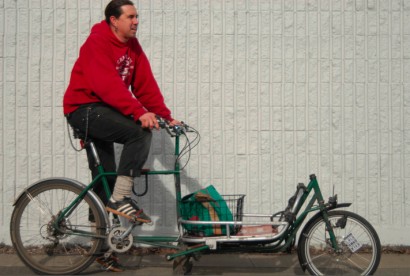
[Publisher’s note: This is the first in a three-part story on Portland’s bike messengers by new contributor Erin Greeson.
When her friend Zak Kovalcik crashed and broke his collarbone last fall, Greeson came face-to-face with the tough reality faced by Portland’s bike delivery professionals. In this in-depth, three-part series, Greeson shares how the deck is stacked against messengers and how they are trying to survive in a challenging profession.]
“The paradigm of the typical messenger service business model is problematic. It’s a pyramid-shaped scheme where the workers are on the bottom.”
–Ira Ryan, former messenger
As Portland’s reputation as a green business boomtown gains momentum, bike-centric ventures emerge as quickly and viably as organic brewpubs and cafes. While a new era of entrepreneurs seeks to capitalize on this evolving economy, one of the oldest bike-based businesses, bicycle messenger services, faces challenges that impact workers and business owners alike.
While the number of inner city cyclists skyrockets, messengers might seem unmistakable amidst the sea of spandex and commuters. However, volumes of fixed-gear fans and track bike hobbyists strive to adopt a messenger-type “look,” so it takes some observation — and better yet, dialogue — to identify working messengers.

Once you get to know these human-powered couriers, you realize their job is demanding on many levels, and that pedaling fast is actually the easiest part.
To get a feel for the nature of their work, I talked with several experienced messengers. I began with Ira Ryan, who is renowned for his signature hand-built bicycles but previously worked as a messenger. During his time as a courier, Ryan found that working conditions were plagued with inherent problems.
“The paradigm of the typical messenger service business model is problematic,” Ryan said. “It is a pyramid-shaped scheme where the workers are on the bottom.”
Ryan explained that messengers are often paid solely on commission; they generally do not enjoy staples that other service industry workers receive, such as hourly pay, worker’s compensation and group health plan buy-in options. Ryan added that the commission-based structure of the business makes it hard for individuals to organize. “The conditions of bike messenger work make it difficult for workers to band together,” he said, “It can be challenging to empathize with the person next to you, because there’s incentive to outwork each other.” In later years, Ryan took significant steps to reject and evolve the faulty system that he described.
Longtime messenger Dee Branham, who has over 13 years of experience in Dallas and Portland, shared similar sentiments. “Bike messengers get a raw deal at every level: the injuries, the low pay, the lack of health insurance,” he said, listing a few core issues. “Plus, fuel cost rate increases put more money in (courier) companies’ pockets without increasing messengers’ pay rates,” Branham added.
Joel Metz expanded on the problematic issues of compensation rates. “Messenger service rates stagnated from the ‘80s through the mid-‘90s,” said Metz, whose impressive 14 years of experience include work in San Francisco, Toronto, London and Portland. “They will likely never be what they ought to be.”

The danger-to-compensation ratio of bike messenger work starkly contrasts with that of other jobs that require constant exposure to hazardous elements. For example, construction workers typically receive relatively higher pay rates and are protected by workman’s compensation laws, if employed by law-abiding companies. Food and beverage service workers in Oregon are granted an hourly wage by law, plus workman’s compensation protection and – in some cases – options to purchase into group health plans. Despite the injury-rich nature of their work, bike messengers typically do not.
“In recent years, the cost of workman’s compensation coverage for bike messengers ranked second highest of all categories.”
— Hazel Gross, bike messenger
Branham explained that the likelihood of injury for bike messengers is virtually inevitable. “It’s not just about the cars,” he said, explaining that — in addition to the risk of collision — constant lifting and repetitive load bearing cause chronic back, neck and shoulder injuries for most messengers.
As I grasped to understand how such a flawed business model could sustain itself in Portland, messengers explained that business owners typically hire couriers as independent contractors. Many messenger business owners cannot or will not face the high cost of workman’s compensation coverage for bike messenger employees, so they often avoid the expense by signing on contractors.
“In recent years, the cost of workman’s compensation coverage for bike messengers ranked second highest of all categories,” said Hazel Gross, an outspoken and experienced member of the community. “Some messenger businesses were faced with a choice: either fire some messengers to afford workman’s comp coverage, or go without it.”
— In the Part Two of this series (read it here), we’ll learn more about health insurance and another challenge for messengers — overcoming stereotypes.


